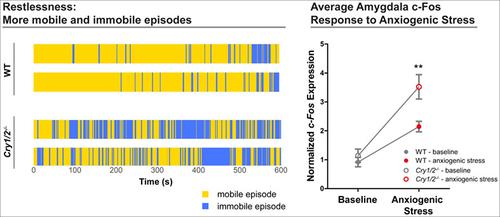当前位置:
X-MOL 学术
›
Genes Brain Behav.
›
论文详情
Our official English website, www.x-mol.net, welcomes your
feedback! (Note: you will need to create a separate account there.)
An in-depth neurobehavioral characterization shows anxiety-like traits, impaired habituation behavior, and restlessness in male Cryptochrome-deficient mice.
Genes, Brain and Behavior ( IF 2.4 ) Pub Date : 2020-04-29 , DOI: 10.1111/gbb.12661 Anisja Hühne 1, 2 , Paul Volkmann 3 , Marius Stephan 3, 4 , Moritz Rossner 3 , Dominic Landgraf 1
Genes, Brain and Behavior ( IF 2.4 ) Pub Date : 2020-04-29 , DOI: 10.1111/gbb.12661 Anisja Hühne 1, 2 , Paul Volkmann 3 , Marius Stephan 3, 4 , Moritz Rossner 3 , Dominic Landgraf 1
Affiliation

|
Many psychiatric disorders, for example, anxiety, are accompanied by disturbances of circadian rhythms, including disturbed sleep/wake cycles, changes in locomotor activity, and abnormal endocrine function. Conversely, alternations of circadian rhythms are a risk factor for the development of psychiatric disorders. This assumption is supported by animals with clock gene mutations which often display behaviors that resemble human psychiatric disorders. In this study, we performed an in‐depth behavioral analysis with male mice lacking the central clock genes Cryptochrome 1 and 2 (Cry1/2−/−), which are thus unable to express endogenous circadian rhythms. With wild‐type and Cry1/2−/− mice, we performed an extensive behavioral analysis to study their cognitive abilities, social behavior, and their expression of depression‐like and anxiety‐like behavior. While Cry1/2−/− mice showed only mild abnormalities at cognitive and social behavioral levels, they were consistently more anxious than wildtype mice. Anxiety‐like behavior was particularly evident in reduced mobility in new environments, altered ability to habituate, compensatory behavior, and consistent restless behavior across many behavioral tests. In line with their anxiety‐like behavioral phenotype, Cry1/2−/− mice have higher c‐Fos activity in the amygdala after exposure to an anxiogenic stressor than wild‐type mice. In our study, we identified Cry1/2−/− mice as animals that qualify as a translational mouse model for anxiety disorder in humans because of its consistent behavior of restlessness, increased immobility, and dysfunctional habituation in new environments.
中文翻译:

深入的神经行为特征显示雄性隐色素缺陷小鼠的焦虑样特征、习惯行为受损和烦躁不安。
许多精神疾病,例如焦虑症,都伴有昼夜节律紊乱,包括睡眠/觉醒周期紊乱、运动活动改变和内分泌功能异常。相反,昼夜节律的改变是精神疾病发展的危险因素。这一假设得到了具有时钟基因突变的动物的支持,这些突变通常表现出类似于人类精神疾病的行为。在这项研究中,我们对缺乏中央时钟基因Cryptochrome 1和2 ( Cry1/2 -/- ) 的雄性小鼠进行了深入的行为分析,因此无法表达内源性昼夜节律。野生型和Cry1/2 -/-小鼠,我们进行了广泛的行为分析,以研究它们的认知能力、社会行为以及它们对抑郁样和焦虑样行为的表达。虽然Cry1/2 -/-小鼠在认知和社会行为水平上仅表现出轻微异常,但它们始终比野生型小鼠更加焦虑。在许多行为测试中,焦虑样行为在新环境中活动能力下降、习惯能力改变、补偿性行为和持续不安的行为中尤为明显。与其焦虑样行为表型一致,与野生型小鼠相比,Cry1/2 -/-小鼠在暴露于焦虑应激源后杏仁核中的c-Fos活性更高。在我们的研究中,我们确定Cry1/2 -/-小鼠作为一种动物,有资格作为人类焦虑症的转化小鼠模型,因为其在新环境中的持续性躁动、增加的不动和功能失调的习惯。
更新日期:2020-04-29
中文翻译:

深入的神经行为特征显示雄性隐色素缺陷小鼠的焦虑样特征、习惯行为受损和烦躁不安。
许多精神疾病,例如焦虑症,都伴有昼夜节律紊乱,包括睡眠/觉醒周期紊乱、运动活动改变和内分泌功能异常。相反,昼夜节律的改变是精神疾病发展的危险因素。这一假设得到了具有时钟基因突变的动物的支持,这些突变通常表现出类似于人类精神疾病的行为。在这项研究中,我们对缺乏中央时钟基因Cryptochrome 1和2 ( Cry1/2 -/- ) 的雄性小鼠进行了深入的行为分析,因此无法表达内源性昼夜节律。野生型和Cry1/2 -/-小鼠,我们进行了广泛的行为分析,以研究它们的认知能力、社会行为以及它们对抑郁样和焦虑样行为的表达。虽然Cry1/2 -/-小鼠在认知和社会行为水平上仅表现出轻微异常,但它们始终比野生型小鼠更加焦虑。在许多行为测试中,焦虑样行为在新环境中活动能力下降、习惯能力改变、补偿性行为和持续不安的行为中尤为明显。与其焦虑样行为表型一致,与野生型小鼠相比,Cry1/2 -/-小鼠在暴露于焦虑应激源后杏仁核中的c-Fos活性更高。在我们的研究中,我们确定Cry1/2 -/-小鼠作为一种动物,有资格作为人类焦虑症的转化小鼠模型,因为其在新环境中的持续性躁动、增加的不动和功能失调的习惯。











































 京公网安备 11010802027423号
京公网安备 11010802027423号